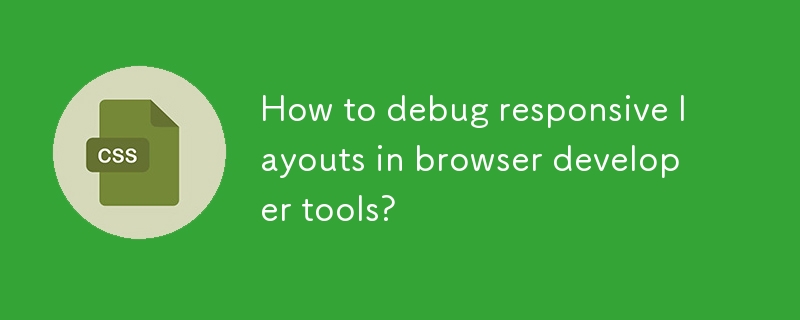
Course Introduction:Chrome's built-in QR code generator can be turned on and used through experimental functions. First, enter chrome://flags/#QR-code-generator in the address bar and enable this function. After restarting the browser, take effect; then right-click the "Share" button in the page address bar and select "Create QR Code" to generate the QR code of the current web page. This function is suitable for desktop version and some Android versions of Chrome. It can be used for offline posters, teaching demonstrations or help unfamiliar operations to access designated pages to improve sharing efficiency.
2025-07-16 comment 0 203

Course Introduction:To achieve the function of jumping to a specific part in a web page, you can achieve it through the following steps: 1. Set a unique id for the target element; 2. Use the #id name to point to the id in the link's href attribute; 3. You can add scroll-behavior:smooth through CSS to achieve smooth scrolling effect; 4. Pay attention to ensuring that the id is unique and has a reasonable naming, avoiding Chinese or retaining keywords; 5. In mobile or single-page applications, you need to ensure that the target element has been loaded or used JavaScript to deal with offset issues.
2025-07-11 comment 0 498

Course Introduction:The allowfullscreen property is used for labels, allowing embedded content to be displayed in full screen. Common writing methods include allowfullscreen, allow="fullscreen" and allow="fullscreen;autoplay;encrypted-media", etc. It is recommended to use the standard writing method allow="fullscreen". If the full screen function does not take effect, it may be due to browser restrictions, parent page permission settings, or the content itself does not support it. In addition, you can finely control permissions through the allow attribute, such as allow="full
2025-07-17 comment 0 924

Course Introduction:Will-change cannot be abused because it will cause additional resource consumption in the browser and prevent optimization. Its function is to inform the browser elements in advance that they will change, thereby triggering optimization mechanisms such as layer improvement and hardware acceleration. However, if you use a large number of elements or unnecessary animations, it will cause excessive memory usage and page jamming. Suitable for frequent moving UI elements (such as sliding menus, pop-up windows), drag elements, complex scrolling animations and other scenarios. Correct usage includes: specifying specific attributes instead of all; adding dynamically when necessary and removing them in time after the animation ends; and implementing mouseenter addition, mouseleave delay removal and other methods to reduce resource usage in combination with JS.
2025-07-05 comment 0 919

Course Introduction:The key to debugging responsive layouts is to utilize the browser developer tools' device emulator, media query checking, layout panels, and real-time editing capabilities. Use the device simulator to view page performance at different resolutions to ensure the correct layout; use the "Computed" panel to check whether the media query rules are effective and prioritized; Chrome's "Layout" panel can visualize the layout details of Grid and Flexbox; finally use the real-time editing function to test style modification and confirm the repair effect. Proficiency in these techniques can help quickly locate and solve problems in responsive design.
2025-07-02 comment 0 680

Course Elementary 13772
Course Introduction:Scala Tutorial Scala is a multi-paradigm programming language, designed to integrate various features of object-oriented programming and functional programming.

Course Elementary 82280
Course Introduction:"CSS Online Manual" is the official CSS online reference manual. This CSS online development manual contains various CSS properties, definitions, usage methods, example operations, etc. It is an indispensable online query manual for WEB programming learners and developers! CSS: Cascading Style Sheets (English full name: Cascading Style Sheets) is an application used to express HTML (Standard Universal Markup Language).

Course Elementary 13144
Course Introduction:SVG is a markup language for vector graphics in HTML5. It maintains powerful drawing capabilities and at the same time has a very high-end interface to operate graphics by directly operating Dom nodes. This "SVG Tutorial" is intended to allow students to master the SVG language and some of its corresponding APIs, combined with the knowledge of 2D drawing, so that students can render and control complex graphics on the page.

Course Elementary 24589
Course Introduction:In the "AngularJS Chinese Reference Manual", AngularJS extends HTML with new attributes and expressions. AngularJS can build a single page application (SPAs: Single Page Applications). AngularJS is very easy to learn.

Course Elementary 27446
Course Introduction:Go is a new language, a concurrent, garbage-collected, fast-compiled language. It can compile a large Go program in a few seconds on a single computer. Go provides a model for software construction that makes dependency analysis easier and avoids most C-style include files and library headers. Go is a statically typed language, and its type system has no hierarchy. Therefore users do not need to spend time defining relationships between types, which feels more lightweight than typical object-oriented languages. Go is a completely garbage-collected language and provides basic support for concurrent execution and communication. By its design, Go is intended to provide a method for constructing system software on multi-core machines.
javascript - How to disable the rubber band effect that appears on sarafi and IE on the mobile side
2017-05-19 10:12:15 0 1 707
Title rewritten as: CSS3's 100vh value is not fixed in mobile browsers
2023-08-21 16:49:22 0 2 610
Laravel Modal does not return data
2024-03-29 10:31:31 0 1 591
Can I use the automatic generation module of thinkphp5 in Windows 7 system? How to configure and use
2017-10-10 17:04:14 0 2 1389